Project Piaxtla: A Successful Example of Participatory Planning in Primary Healthcare
VerifiedAdded on 2023/06/11
|8
|3561
|410
AI Summary
Project Piaxtla was a small program related to primary health care, which was run by the local villagers, in the mountains of western Mexico. It was named over a local river situated in the hills of Sierra Madre. The project Piaxtla was started in 1965, with the main objective to encounter the disease which was arises because of poverty. This essay discusses the work of Project Piaxtla, its impact on the community, and the challenges it faced. It also highlights the success of the program, which was the result of proper participatory planning and people empowerment.
Contribute Materials
Your contribution can guide someone’s learning journey. Share your
documents today.
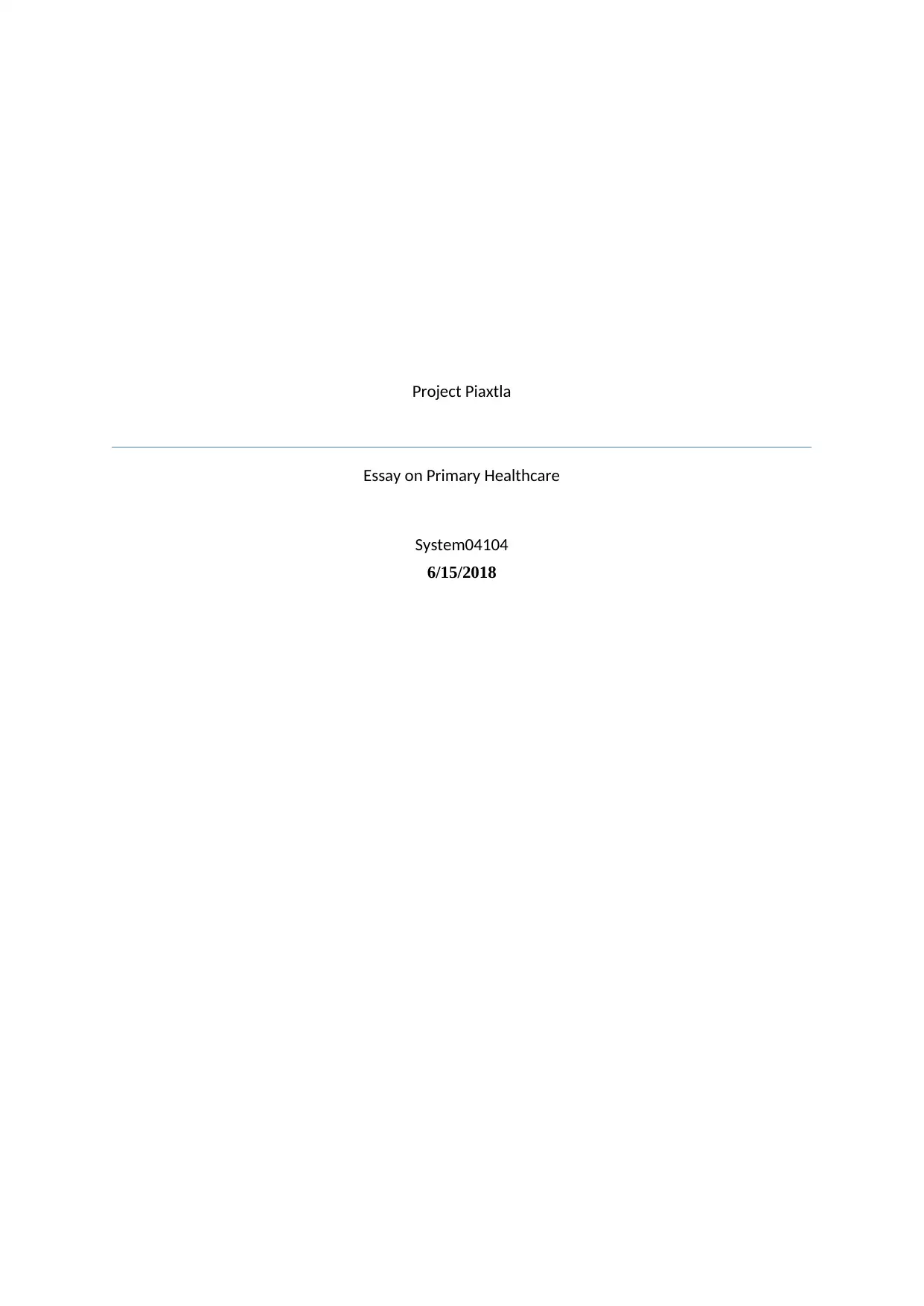
Project Piaxtla
Essay on Primary Healthcare
System04104
6/15/2018
Essay on Primary Healthcare
System04104
6/15/2018
Secure Best Marks with AI Grader
Need help grading? Try our AI Grader for instant feedback on your assignments.

INTRODUCTION
Project Piaxtla was a small program related to primary health care, which was run by the
local villagers, in the mountains of western Mexico. It was named over a local river situated
in the hills of Sierra Madre. The project Piaxtla was started in 1965, with the main objective
to encounter the disease which was arises because of poverty. When Project Piaxtla was
started, the area was totally undeveloped and even there was no road or infrastructure and the
rural people were suffering from number of disease such as measles, polio, pneumonia,
malaria, Anaemia which was arises because of the unavailability of water, foods and basic
resources. The distribution of land, wealth and power was totally in inequitable and some of
them having small piece of land which was in inferior quality. In opposite, a few people of
that area acquire large part of productive and fertile land and had large number of cattle, and
were prosperous people. The man behind this project from the commencement of the project
as an advisor and facilitator was David Werner. Land and wealth distribution was the big
issue in Mexico since 1910, Mexico revolution. When Diaz dictatorship was deposed, a new
revolutionary was constituted, named ‘ejido system’. This system facilitate the small villagers
that they can collectively form an ejido or communal land holding and the local farmland was
allocated impartially among all families which they can use for farming and agriculture but
still the ownership stayed with the ejido. But when the corrupt and brutal Institutional
Revolutionary Party (IPR) back in the government they abolish all the systems and laws that
restrictive the size of land properties and failed to protect the rights of poor farmers.
Work of Project Piaxtla
Establishment of a cooperative maize bank
Project Piaxtla established a maize bank that provide loans to the small farmers on a very
much lower interest rate in compare to rich farmers who charged heavy interest rate on their
loans. The bank charged very minimal rate of interest which was collected because that helps
to increase the lending capacity of the bank (MPMP, 2014). The favourable community
oriented loan program was conducted and spread in five small villages and helped to improve
the economic condition of the community and provide financial security against the rich
farmers and lenders of that area (Warner and Sanders, 2014). The good thing was that people
started to belief in their self and bring confidence in their own ability to improve their
situation and the result of such help was that they were educating them self to fight for
constitutional rights. After that, Ajoya and the near community create an organization of poor
farmers and they were organized and they started to break the control of some wealthy people
having control over them. (Revolvy, 2017).
Fencing of maize farm
Team Piaxtla provide all the fencing facilities to the poor and small farmers to protect their
maize farms from rich agrarian’s cattle from entering their cattle and eating and destroying
Project Piaxtla was a small program related to primary health care, which was run by the
local villagers, in the mountains of western Mexico. It was named over a local river situated
in the hills of Sierra Madre. The project Piaxtla was started in 1965, with the main objective
to encounter the disease which was arises because of poverty. When Project Piaxtla was
started, the area was totally undeveloped and even there was no road or infrastructure and the
rural people were suffering from number of disease such as measles, polio, pneumonia,
malaria, Anaemia which was arises because of the unavailability of water, foods and basic
resources. The distribution of land, wealth and power was totally in inequitable and some of
them having small piece of land which was in inferior quality. In opposite, a few people of
that area acquire large part of productive and fertile land and had large number of cattle, and
were prosperous people. The man behind this project from the commencement of the project
as an advisor and facilitator was David Werner. Land and wealth distribution was the big
issue in Mexico since 1910, Mexico revolution. When Diaz dictatorship was deposed, a new
revolutionary was constituted, named ‘ejido system’. This system facilitate the small villagers
that they can collectively form an ejido or communal land holding and the local farmland was
allocated impartially among all families which they can use for farming and agriculture but
still the ownership stayed with the ejido. But when the corrupt and brutal Institutional
Revolutionary Party (IPR) back in the government they abolish all the systems and laws that
restrictive the size of land properties and failed to protect the rights of poor farmers.
Work of Project Piaxtla
Establishment of a cooperative maize bank
Project Piaxtla established a maize bank that provide loans to the small farmers on a very
much lower interest rate in compare to rich farmers who charged heavy interest rate on their
loans. The bank charged very minimal rate of interest which was collected because that helps
to increase the lending capacity of the bank (MPMP, 2014). The favourable community
oriented loan program was conducted and spread in five small villages and helped to improve
the economic condition of the community and provide financial security against the rich
farmers and lenders of that area (Warner and Sanders, 2014). The good thing was that people
started to belief in their self and bring confidence in their own ability to improve their
situation and the result of such help was that they were educating them self to fight for
constitutional rights. After that, Ajoya and the near community create an organization of poor
farmers and they were organized and they started to break the control of some wealthy people
having control over them. (Revolvy, 2017).
Fencing of maize farm
Team Piaxtla provide all the fencing facilities to the poor and small farmers to protect their
maize farms from rich agrarian’s cattle from entering their cattle and eating and destroying
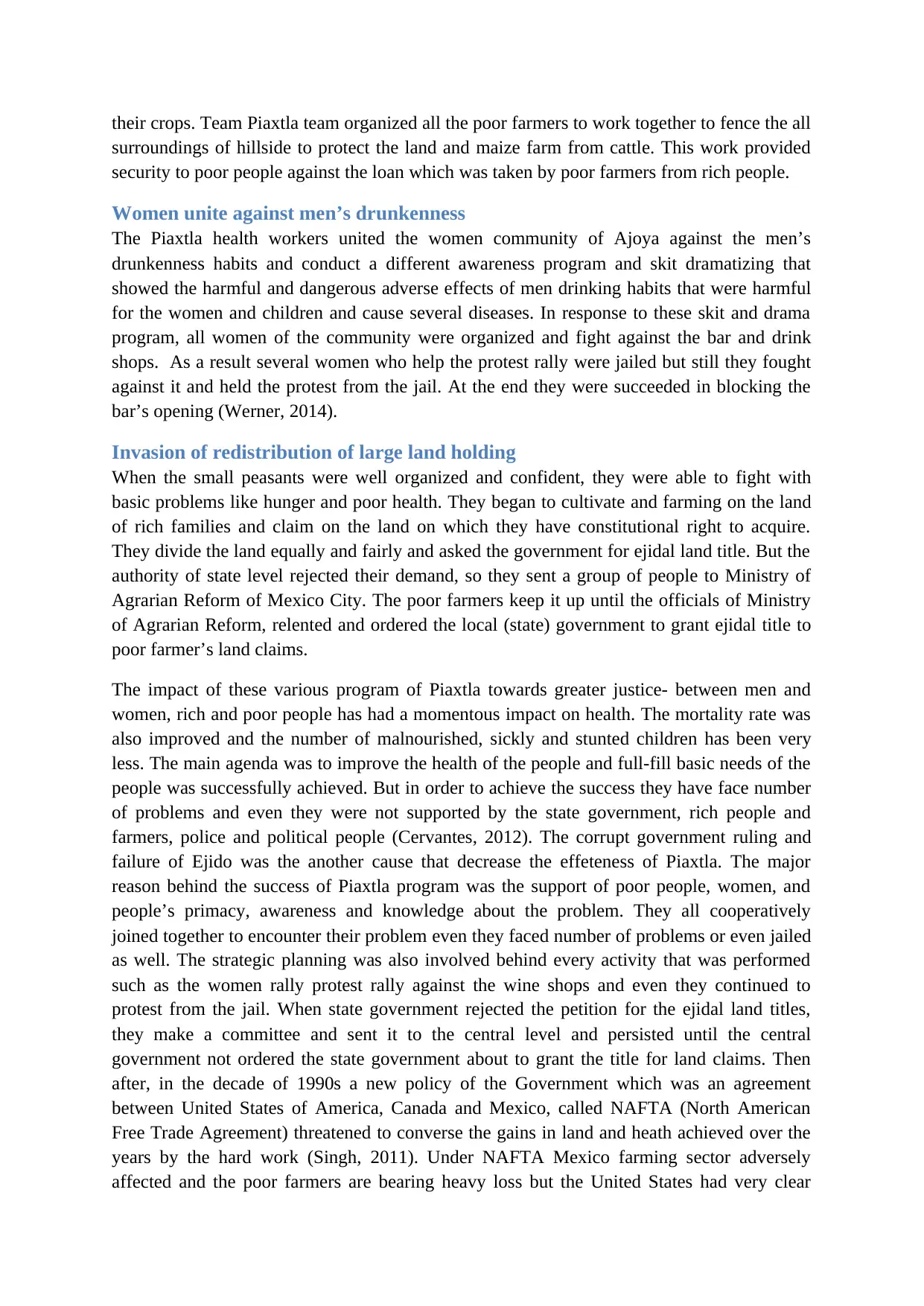
their crops. Team Piaxtla team organized all the poor farmers to work together to fence the all
surroundings of hillside to protect the land and maize farm from cattle. This work provided
security to poor people against the loan which was taken by poor farmers from rich people.
Women unite against men’s drunkenness
The Piaxtla health workers united the women community of Ajoya against the men’s
drunkenness habits and conduct a different awareness program and skit dramatizing that
showed the harmful and dangerous adverse effects of men drinking habits that were harmful
for the women and children and cause several diseases. In response to these skit and drama
program, all women of the community were organized and fight against the bar and drink
shops. As a result several women who help the protest rally were jailed but still they fought
against it and held the protest from the jail. At the end they were succeeded in blocking the
bar’s opening (Werner, 2014).
Invasion of redistribution of large land holding
When the small peasants were well organized and confident, they were able to fight with
basic problems like hunger and poor health. They began to cultivate and farming on the land
of rich families and claim on the land on which they have constitutional right to acquire.
They divide the land equally and fairly and asked the government for ejidal land title. But the
authority of state level rejected their demand, so they sent a group of people to Ministry of
Agrarian Reform of Mexico City. The poor farmers keep it up until the officials of Ministry
of Agrarian Reform, relented and ordered the local (state) government to grant ejidal title to
poor farmer’s land claims.
The impact of these various program of Piaxtla towards greater justice- between men and
women, rich and poor people has had a momentous impact on health. The mortality rate was
also improved and the number of malnourished, sickly and stunted children has been very
less. The main agenda was to improve the health of the people and full-fill basic needs of the
people was successfully achieved. But in order to achieve the success they have face number
of problems and even they were not supported by the state government, rich people and
farmers, police and political people (Cervantes, 2012). The corrupt government ruling and
failure of Ejido was the another cause that decrease the effeteness of Piaxtla. The major
reason behind the success of Piaxtla program was the support of poor people, women, and
people’s primacy, awareness and knowledge about the problem. They all cooperatively
joined together to encounter their problem even they faced number of problems or even jailed
as well. The strategic planning was also involved behind every activity that was performed
such as the women rally protest rally against the wine shops and even they continued to
protest from the jail. When state government rejected the petition for the ejidal land titles,
they make a committee and sent it to the central level and persisted until the central
government not ordered the state government about to grant the title for land claims. Then
after, in the decade of 1990s a new policy of the Government which was an agreement
between United States of America, Canada and Mexico, called NAFTA (North American
Free Trade Agreement) threatened to converse the gains in land and heath achieved over the
years by the hard work (Singh, 2011). Under NAFTA Mexico farming sector adversely
affected and the poor farmers are bearing heavy loss but the United States had very clear
surroundings of hillside to protect the land and maize farm from cattle. This work provided
security to poor people against the loan which was taken by poor farmers from rich people.
Women unite against men’s drunkenness
The Piaxtla health workers united the women community of Ajoya against the men’s
drunkenness habits and conduct a different awareness program and skit dramatizing that
showed the harmful and dangerous adverse effects of men drinking habits that were harmful
for the women and children and cause several diseases. In response to these skit and drama
program, all women of the community were organized and fight against the bar and drink
shops. As a result several women who help the protest rally were jailed but still they fought
against it and held the protest from the jail. At the end they were succeeded in blocking the
bar’s opening (Werner, 2014).
Invasion of redistribution of large land holding
When the small peasants were well organized and confident, they were able to fight with
basic problems like hunger and poor health. They began to cultivate and farming on the land
of rich families and claim on the land on which they have constitutional right to acquire.
They divide the land equally and fairly and asked the government for ejidal land title. But the
authority of state level rejected their demand, so they sent a group of people to Ministry of
Agrarian Reform of Mexico City. The poor farmers keep it up until the officials of Ministry
of Agrarian Reform, relented and ordered the local (state) government to grant ejidal title to
poor farmer’s land claims.
The impact of these various program of Piaxtla towards greater justice- between men and
women, rich and poor people has had a momentous impact on health. The mortality rate was
also improved and the number of malnourished, sickly and stunted children has been very
less. The main agenda was to improve the health of the people and full-fill basic needs of the
people was successfully achieved. But in order to achieve the success they have face number
of problems and even they were not supported by the state government, rich people and
farmers, police and political people (Cervantes, 2012). The corrupt government ruling and
failure of Ejido was the another cause that decrease the effeteness of Piaxtla. The major
reason behind the success of Piaxtla program was the support of poor people, women, and
people’s primacy, awareness and knowledge about the problem. They all cooperatively
joined together to encounter their problem even they faced number of problems or even jailed
as well. The strategic planning was also involved behind every activity that was performed
such as the women rally protest rally against the wine shops and even they continued to
protest from the jail. When state government rejected the petition for the ejidal land titles,
they make a committee and sent it to the central level and persisted until the central
government not ordered the state government about to grant the title for land claims. Then
after, in the decade of 1990s a new policy of the Government which was an agreement
between United States of America, Canada and Mexico, called NAFTA (North American
Free Trade Agreement) threatened to converse the gains in land and heath achieved over the
years by the hard work (Singh, 2011). Under NAFTA Mexico farming sector adversely
affected and the poor farmers are bearing heavy loss but the United States had very clear
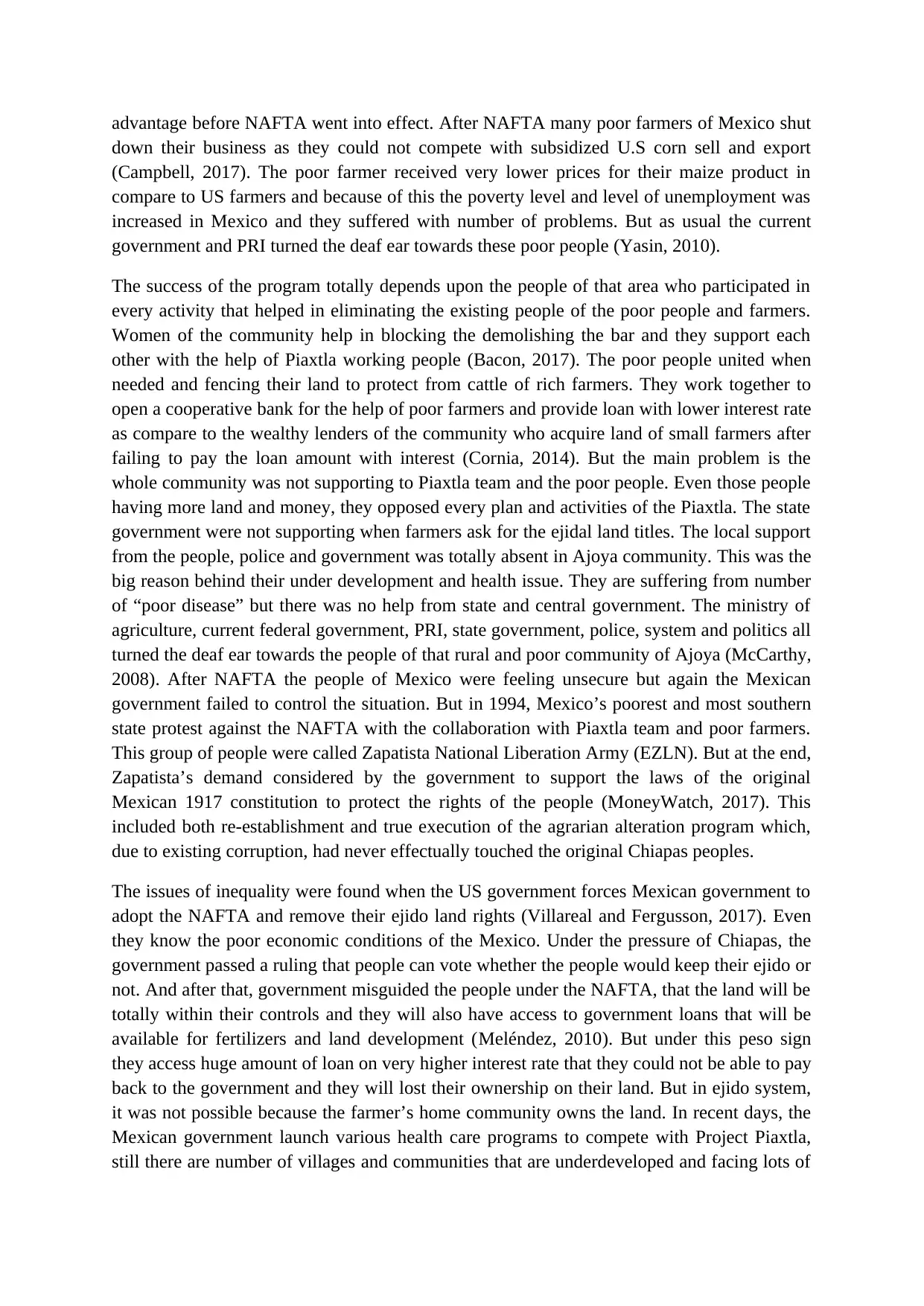
advantage before NAFTA went into effect. After NAFTA many poor farmers of Mexico shut
down their business as they could not compete with subsidized U.S corn sell and export
(Campbell, 2017). The poor farmer received very lower prices for their maize product in
compare to US farmers and because of this the poverty level and level of unemployment was
increased in Mexico and they suffered with number of problems. But as usual the current
government and PRI turned the deaf ear towards these poor people (Yasin, 2010).
The success of the program totally depends upon the people of that area who participated in
every activity that helped in eliminating the existing people of the poor people and farmers.
Women of the community help in blocking the demolishing the bar and they support each
other with the help of Piaxtla working people (Bacon, 2017). The poor people united when
needed and fencing their land to protect from cattle of rich farmers. They work together to
open a cooperative bank for the help of poor farmers and provide loan with lower interest rate
as compare to the wealthy lenders of the community who acquire land of small farmers after
failing to pay the loan amount with interest (Cornia, 2014). But the main problem is the
whole community was not supporting to Piaxtla team and the poor people. Even those people
having more land and money, they opposed every plan and activities of the Piaxtla. The state
government were not supporting when farmers ask for the ejidal land titles. The local support
from the people, police and government was totally absent in Ajoya community. This was the
big reason behind their under development and health issue. They are suffering from number
of “poor disease” but there was no help from state and central government. The ministry of
agriculture, current federal government, PRI, state government, police, system and politics all
turned the deaf ear towards the people of that rural and poor community of Ajoya (McCarthy,
2008). After NAFTA the people of Mexico were feeling unsecure but again the Mexican
government failed to control the situation. But in 1994, Mexico’s poorest and most southern
state protest against the NAFTA with the collaboration with Piaxtla team and poor farmers.
This group of people were called Zapatista National Liberation Army (EZLN). But at the end,
Zapatista’s demand considered by the government to support the laws of the original
Mexican 1917 constitution to protect the rights of the people (MoneyWatch, 2017). This
included both re-establishment and true execution of the agrarian alteration program which,
due to existing corruption, had never effectually touched the original Chiapas peoples.
The issues of inequality were found when the US government forces Mexican government to
adopt the NAFTA and remove their ejido land rights (Villareal and Fergusson, 2017). Even
they know the poor economic conditions of the Mexico. Under the pressure of Chiapas, the
government passed a ruling that people can vote whether the people would keep their ejido or
not. And after that, government misguided the people under the NAFTA, that the land will be
totally within their controls and they will also have access to government loans that will be
available for fertilizers and land development (Meléndez, 2010). But under this peso sign
they access huge amount of loan on very higher interest rate that they could not be able to pay
back to the government and they will lost their ownership on their land. But in ejido system,
it was not possible because the farmer’s home community owns the land. In recent days, the
Mexican government launch various health care programs to compete with Project Piaxtla,
still there are number of villages and communities that are underdeveloped and facing lots of
down their business as they could not compete with subsidized U.S corn sell and export
(Campbell, 2017). The poor farmer received very lower prices for their maize product in
compare to US farmers and because of this the poverty level and level of unemployment was
increased in Mexico and they suffered with number of problems. But as usual the current
government and PRI turned the deaf ear towards these poor people (Yasin, 2010).
The success of the program totally depends upon the people of that area who participated in
every activity that helped in eliminating the existing people of the poor people and farmers.
Women of the community help in blocking the demolishing the bar and they support each
other with the help of Piaxtla working people (Bacon, 2017). The poor people united when
needed and fencing their land to protect from cattle of rich farmers. They work together to
open a cooperative bank for the help of poor farmers and provide loan with lower interest rate
as compare to the wealthy lenders of the community who acquire land of small farmers after
failing to pay the loan amount with interest (Cornia, 2014). But the main problem is the
whole community was not supporting to Piaxtla team and the poor people. Even those people
having more land and money, they opposed every plan and activities of the Piaxtla. The state
government were not supporting when farmers ask for the ejidal land titles. The local support
from the people, police and government was totally absent in Ajoya community. This was the
big reason behind their under development and health issue. They are suffering from number
of “poor disease” but there was no help from state and central government. The ministry of
agriculture, current federal government, PRI, state government, police, system and politics all
turned the deaf ear towards the people of that rural and poor community of Ajoya (McCarthy,
2008). After NAFTA the people of Mexico were feeling unsecure but again the Mexican
government failed to control the situation. But in 1994, Mexico’s poorest and most southern
state protest against the NAFTA with the collaboration with Piaxtla team and poor farmers.
This group of people were called Zapatista National Liberation Army (EZLN). But at the end,
Zapatista’s demand considered by the government to support the laws of the original
Mexican 1917 constitution to protect the rights of the people (MoneyWatch, 2017). This
included both re-establishment and true execution of the agrarian alteration program which,
due to existing corruption, had never effectually touched the original Chiapas peoples.
The issues of inequality were found when the US government forces Mexican government to
adopt the NAFTA and remove their ejido land rights (Villareal and Fergusson, 2017). Even
they know the poor economic conditions of the Mexico. Under the pressure of Chiapas, the
government passed a ruling that people can vote whether the people would keep their ejido or
not. And after that, government misguided the people under the NAFTA, that the land will be
totally within their controls and they will also have access to government loans that will be
available for fertilizers and land development (Meléndez, 2010). But under this peso sign
they access huge amount of loan on very higher interest rate that they could not be able to pay
back to the government and they will lost their ownership on their land. But in ejido system,
it was not possible because the farmer’s home community owns the land. In recent days, the
Mexican government launch various health care programs to compete with Project Piaxtla,
still there are number of villages and communities that are underdeveloped and facing lots of
Secure Best Marks with AI Grader
Need help grading? Try our AI Grader for instant feedback on your assignments.
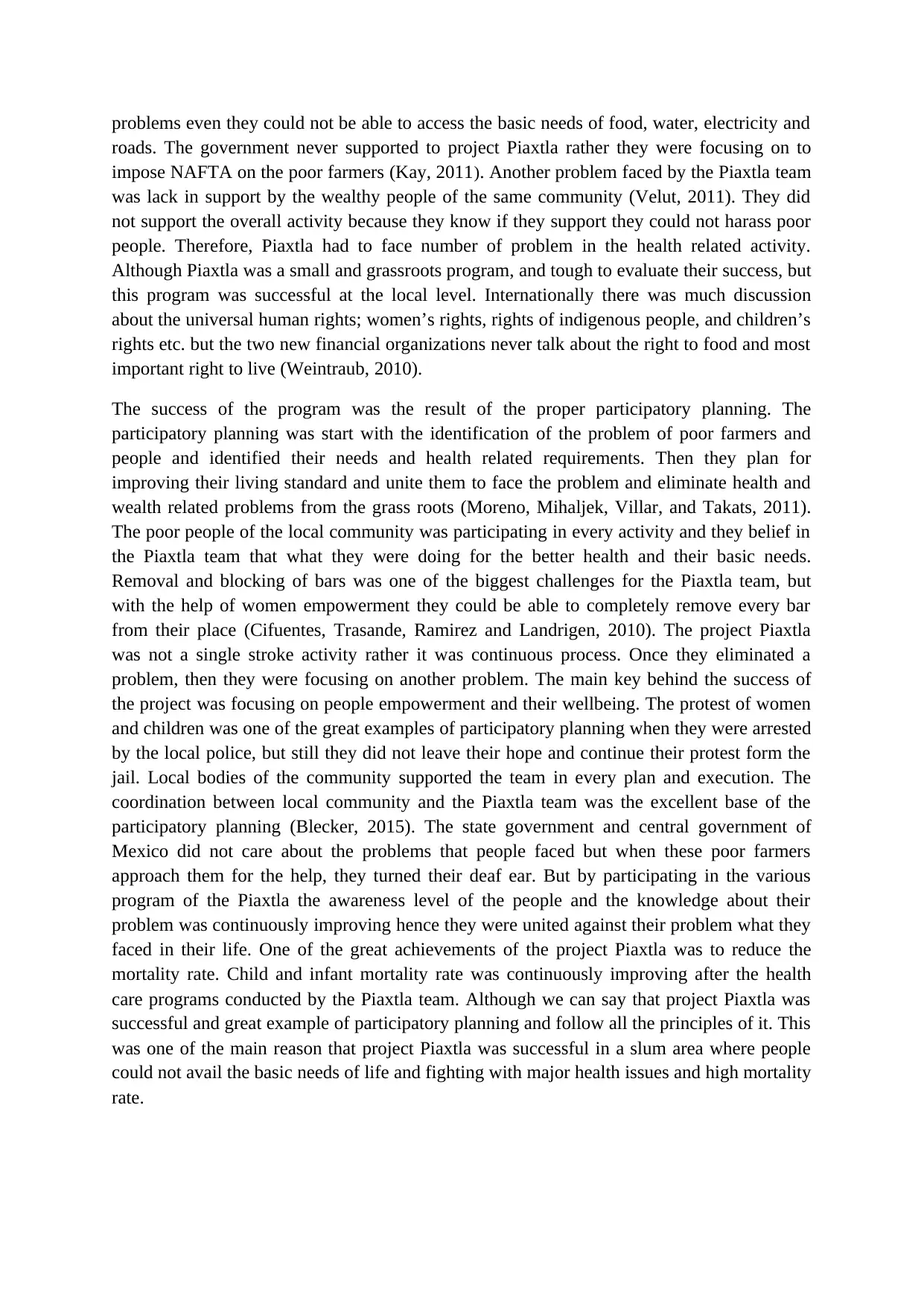
problems even they could not be able to access the basic needs of food, water, electricity and
roads. The government never supported to project Piaxtla rather they were focusing on to
impose NAFTA on the poor farmers (Kay, 2011). Another problem faced by the Piaxtla team
was lack in support by the wealthy people of the same community (Velut, 2011). They did
not support the overall activity because they know if they support they could not harass poor
people. Therefore, Piaxtla had to face number of problem in the health related activity.
Although Piaxtla was a small and grassroots program, and tough to evaluate their success, but
this program was successful at the local level. Internationally there was much discussion
about the universal human rights; women’s rights, rights of indigenous people, and children’s
rights etc. but the two new financial organizations never talk about the right to food and most
important right to live (Weintraub, 2010).
The success of the program was the result of the proper participatory planning. The
participatory planning was start with the identification of the problem of poor farmers and
people and identified their needs and health related requirements. Then they plan for
improving their living standard and unite them to face the problem and eliminate health and
wealth related problems from the grass roots (Moreno, Mihaljek, Villar, and Takats, 2011).
The poor people of the local community was participating in every activity and they belief in
the Piaxtla team that what they were doing for the better health and their basic needs.
Removal and blocking of bars was one of the biggest challenges for the Piaxtla team, but
with the help of women empowerment they could be able to completely remove every bar
from their place (Cifuentes, Trasande, Ramirez and Landrigen, 2010). The project Piaxtla
was not a single stroke activity rather it was continuous process. Once they eliminated a
problem, then they were focusing on another problem. The main key behind the success of
the project was focusing on people empowerment and their wellbeing. The protest of women
and children was one of the great examples of participatory planning when they were arrested
by the local police, but still they did not leave their hope and continue their protest form the
jail. Local bodies of the community supported the team in every plan and execution. The
coordination between local community and the Piaxtla team was the excellent base of the
participatory planning (Blecker, 2015). The state government and central government of
Mexico did not care about the problems that people faced but when these poor farmers
approach them for the help, they turned their deaf ear. But by participating in the various
program of the Piaxtla the awareness level of the people and the knowledge about their
problem was continuously improving hence they were united against their problem what they
faced in their life. One of the great achievements of the project Piaxtla was to reduce the
mortality rate. Child and infant mortality rate was continuously improving after the health
care programs conducted by the Piaxtla team. Although we can say that project Piaxtla was
successful and great example of participatory planning and follow all the principles of it. This
was one of the main reason that project Piaxtla was successful in a slum area where people
could not avail the basic needs of life and fighting with major health issues and high mortality
rate.
roads. The government never supported to project Piaxtla rather they were focusing on to
impose NAFTA on the poor farmers (Kay, 2011). Another problem faced by the Piaxtla team
was lack in support by the wealthy people of the same community (Velut, 2011). They did
not support the overall activity because they know if they support they could not harass poor
people. Therefore, Piaxtla had to face number of problem in the health related activity.
Although Piaxtla was a small and grassroots program, and tough to evaluate their success, but
this program was successful at the local level. Internationally there was much discussion
about the universal human rights; women’s rights, rights of indigenous people, and children’s
rights etc. but the two new financial organizations never talk about the right to food and most
important right to live (Weintraub, 2010).
The success of the program was the result of the proper participatory planning. The
participatory planning was start with the identification of the problem of poor farmers and
people and identified their needs and health related requirements. Then they plan for
improving their living standard and unite them to face the problem and eliminate health and
wealth related problems from the grass roots (Moreno, Mihaljek, Villar, and Takats, 2011).
The poor people of the local community was participating in every activity and they belief in
the Piaxtla team that what they were doing for the better health and their basic needs.
Removal and blocking of bars was one of the biggest challenges for the Piaxtla team, but
with the help of women empowerment they could be able to completely remove every bar
from their place (Cifuentes, Trasande, Ramirez and Landrigen, 2010). The project Piaxtla
was not a single stroke activity rather it was continuous process. Once they eliminated a
problem, then they were focusing on another problem. The main key behind the success of
the project was focusing on people empowerment and their wellbeing. The protest of women
and children was one of the great examples of participatory planning when they were arrested
by the local police, but still they did not leave their hope and continue their protest form the
jail. Local bodies of the community supported the team in every plan and execution. The
coordination between local community and the Piaxtla team was the excellent base of the
participatory planning (Blecker, 2015). The state government and central government of
Mexico did not care about the problems that people faced but when these poor farmers
approach them for the help, they turned their deaf ear. But by participating in the various
program of the Piaxtla the awareness level of the people and the knowledge about their
problem was continuously improving hence they were united against their problem what they
faced in their life. One of the great achievements of the project Piaxtla was to reduce the
mortality rate. Child and infant mortality rate was continuously improving after the health
care programs conducted by the Piaxtla team. Although we can say that project Piaxtla was
successful and great example of participatory planning and follow all the principles of it. This
was one of the main reason that project Piaxtla was successful in a slum area where people
could not avail the basic needs of life and fighting with major health issues and high mortality
rate.
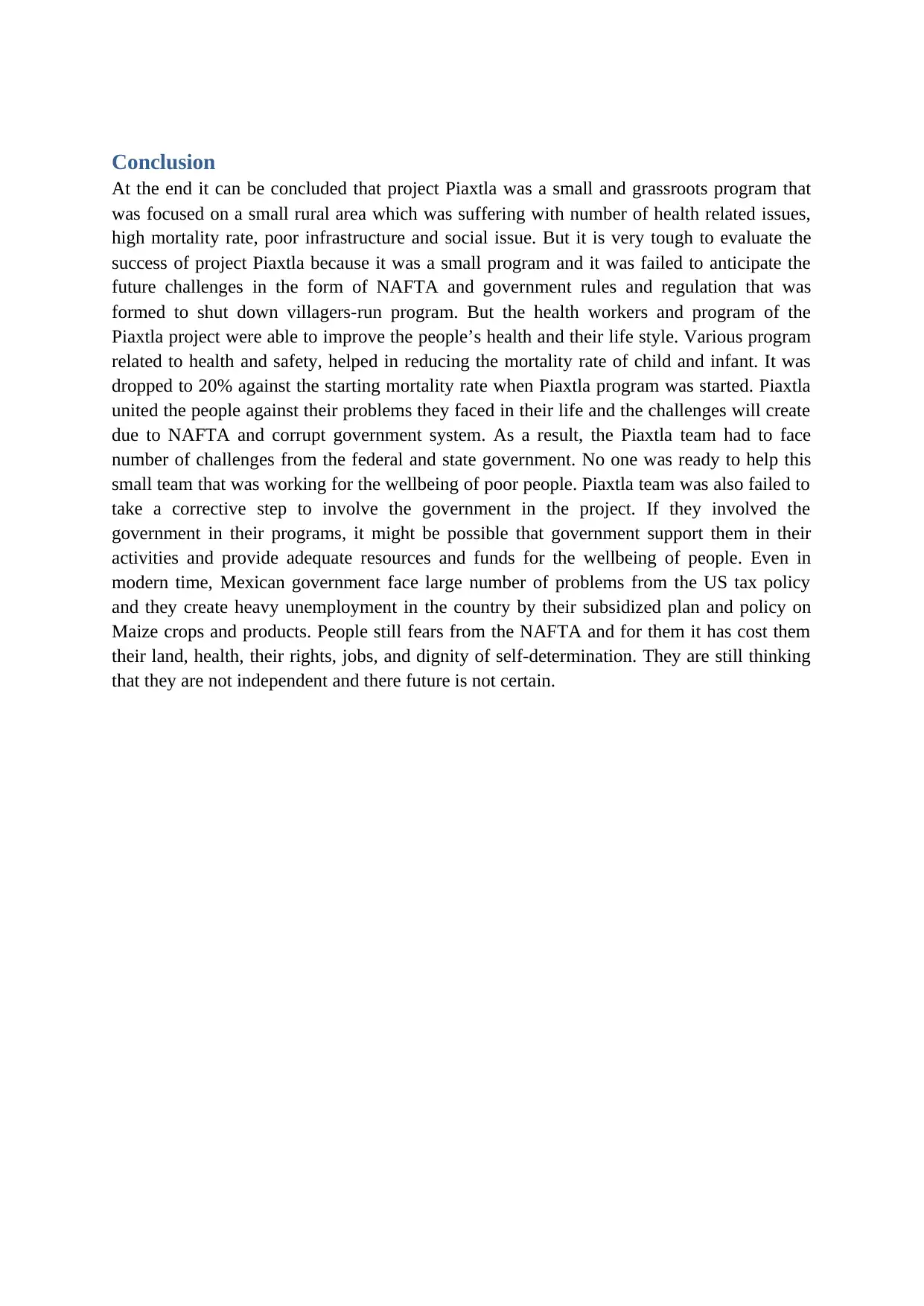
Conclusion
At the end it can be concluded that project Piaxtla was a small and grassroots program that
was focused on a small rural area which was suffering with number of health related issues,
high mortality rate, poor infrastructure and social issue. But it is very tough to evaluate the
success of project Piaxtla because it was a small program and it was failed to anticipate the
future challenges in the form of NAFTA and government rules and regulation that was
formed to shut down villagers-run program. But the health workers and program of the
Piaxtla project were able to improve the people’s health and their life style. Various program
related to health and safety, helped in reducing the mortality rate of child and infant. It was
dropped to 20% against the starting mortality rate when Piaxtla program was started. Piaxtla
united the people against their problems they faced in their life and the challenges will create
due to NAFTA and corrupt government system. As a result, the Piaxtla team had to face
number of challenges from the federal and state government. No one was ready to help this
small team that was working for the wellbeing of poor people. Piaxtla team was also failed to
take a corrective step to involve the government in the project. If they involved the
government in their programs, it might be possible that government support them in their
activities and provide adequate resources and funds for the wellbeing of people. Even in
modern time, Mexican government face large number of problems from the US tax policy
and they create heavy unemployment in the country by their subsidized plan and policy on
Maize crops and products. People still fears from the NAFTA and for them it has cost them
their land, health, their rights, jobs, and dignity of self-determination. They are still thinking
that they are not independent and there future is not certain.
At the end it can be concluded that project Piaxtla was a small and grassroots program that
was focused on a small rural area which was suffering with number of health related issues,
high mortality rate, poor infrastructure and social issue. But it is very tough to evaluate the
success of project Piaxtla because it was a small program and it was failed to anticipate the
future challenges in the form of NAFTA and government rules and regulation that was
formed to shut down villagers-run program. But the health workers and program of the
Piaxtla project were able to improve the people’s health and their life style. Various program
related to health and safety, helped in reducing the mortality rate of child and infant. It was
dropped to 20% against the starting mortality rate when Piaxtla program was started. Piaxtla
united the people against their problems they faced in their life and the challenges will create
due to NAFTA and corrupt government system. As a result, the Piaxtla team had to face
number of challenges from the federal and state government. No one was ready to help this
small team that was working for the wellbeing of poor people. Piaxtla team was also failed to
take a corrective step to involve the government in the project. If they involved the
government in their programs, it might be possible that government support them in their
activities and provide adequate resources and funds for the wellbeing of people. Even in
modern time, Mexican government face large number of problems from the US tax policy
and they create heavy unemployment in the country by their subsidized plan and policy on
Maize crops and products. People still fears from the NAFTA and for them it has cost them
their land, health, their rights, jobs, and dignity of self-determination. They are still thinking
that they are not independent and there future is not certain.
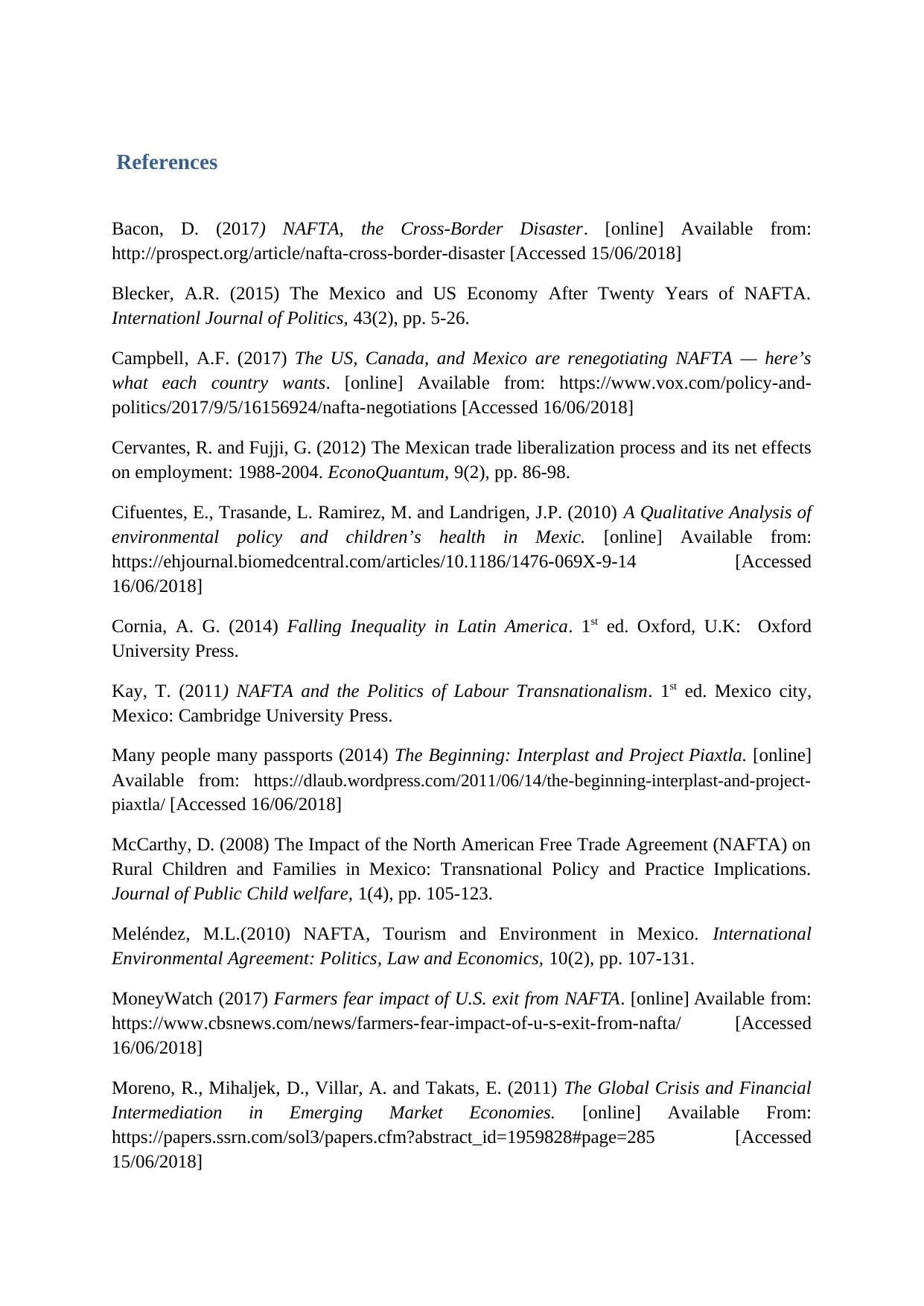
References
Bacon, D. (2017) NAFTA, the Cross-Border Disaster. [online] Available from:
http://prospect.org/article/nafta-cross-border-disaster [Accessed 15/06/2018]
Blecker, A.R. (2015) The Mexico and US Economy After Twenty Years of NAFTA.
Internationl Journal of Politics, 43(2), pp. 5-26.
Campbell, A.F. (2017) The US, Canada, and Mexico are renegotiating NAFTA — here’s
what each country wants. [online] Available from: https://www.vox.com/policy-and-
politics/2017/9/5/16156924/nafta-negotiations [Accessed 16/06/2018]
Cervantes, R. and Fujji, G. (2012) The Mexican trade liberalization process and its net effects
on employment: 1988-2004. EconoQuantum, 9(2), pp. 86-98.
Cifuentes, E., Trasande, L. Ramirez, M. and Landrigen, J.P. (2010) A Qualitative Analysis of
environmental policy and children’s health in Mexic. [online] Available from:
https://ehjournal.biomedcentral.com/articles/10.1186/1476-069X-9-14 [Accessed
16/06/2018]
Cornia, A. G. (2014) Falling Inequality in Latin America. 1st ed. Oxford, U.K: Oxford
University Press.
Kay, T. (2011) NAFTA and the Politics of Labour Transnationalism. 1st ed. Mexico city,
Mexico: Cambridge University Press.
Many people many passports (2014) The Beginning: Interplast and Project Piaxtla. [online]
Available from: https://dlaub.wordpress.com/2011/06/14/the-beginning-interplast-and-project-
piaxtla/ [Accessed 16/06/2018]
McCarthy, D. (2008) The Impact of the North American Free Trade Agreement (NAFTA) on
Rural Children and Families in Mexico: Transnational Policy and Practice Implications.
Journal of Public Child welfare, 1(4), pp. 105-123.
Meléndez, M.L.(2010) NAFTA, Tourism and Environment in Mexico. International
Environmental Agreement: Politics, Law and Economics, 10(2), pp. 107-131.
MoneyWatch (2017) Farmers fear impact of U.S. exit from NAFTA. [online] Available from:
https://www.cbsnews.com/news/farmers-fear-impact-of-u-s-exit-from-nafta/ [Accessed
16/06/2018]
Moreno, R., Mihaljek, D., Villar, A. and Takats, E. (2011) The Global Crisis and Financial
Intermediation in Emerging Market Economies. [online] Available From:
https://papers.ssrn.com/sol3/papers.cfm?abstract_id=1959828#page=285 [Accessed
15/06/2018]
Bacon, D. (2017) NAFTA, the Cross-Border Disaster. [online] Available from:
http://prospect.org/article/nafta-cross-border-disaster [Accessed 15/06/2018]
Blecker, A.R. (2015) The Mexico and US Economy After Twenty Years of NAFTA.
Internationl Journal of Politics, 43(2), pp. 5-26.
Campbell, A.F. (2017) The US, Canada, and Mexico are renegotiating NAFTA — here’s
what each country wants. [online] Available from: https://www.vox.com/policy-and-
politics/2017/9/5/16156924/nafta-negotiations [Accessed 16/06/2018]
Cervantes, R. and Fujji, G. (2012) The Mexican trade liberalization process and its net effects
on employment: 1988-2004. EconoQuantum, 9(2), pp. 86-98.
Cifuentes, E., Trasande, L. Ramirez, M. and Landrigen, J.P. (2010) A Qualitative Analysis of
environmental policy and children’s health in Mexic. [online] Available from:
https://ehjournal.biomedcentral.com/articles/10.1186/1476-069X-9-14 [Accessed
16/06/2018]
Cornia, A. G. (2014) Falling Inequality in Latin America. 1st ed. Oxford, U.K: Oxford
University Press.
Kay, T. (2011) NAFTA and the Politics of Labour Transnationalism. 1st ed. Mexico city,
Mexico: Cambridge University Press.
Many people many passports (2014) The Beginning: Interplast and Project Piaxtla. [online]
Available from: https://dlaub.wordpress.com/2011/06/14/the-beginning-interplast-and-project-
piaxtla/ [Accessed 16/06/2018]
McCarthy, D. (2008) The Impact of the North American Free Trade Agreement (NAFTA) on
Rural Children and Families in Mexico: Transnational Policy and Practice Implications.
Journal of Public Child welfare, 1(4), pp. 105-123.
Meléndez, M.L.(2010) NAFTA, Tourism and Environment in Mexico. International
Environmental Agreement: Politics, Law and Economics, 10(2), pp. 107-131.
MoneyWatch (2017) Farmers fear impact of U.S. exit from NAFTA. [online] Available from:
https://www.cbsnews.com/news/farmers-fear-impact-of-u-s-exit-from-nafta/ [Accessed
16/06/2018]
Moreno, R., Mihaljek, D., Villar, A. and Takats, E. (2011) The Global Crisis and Financial
Intermediation in Emerging Market Economies. [online] Available From:
https://papers.ssrn.com/sol3/papers.cfm?abstract_id=1959828#page=285 [Accessed
15/06/2018]
Paraphrase This Document
Need a fresh take? Get an instant paraphrase of this document with our AI Paraphraser
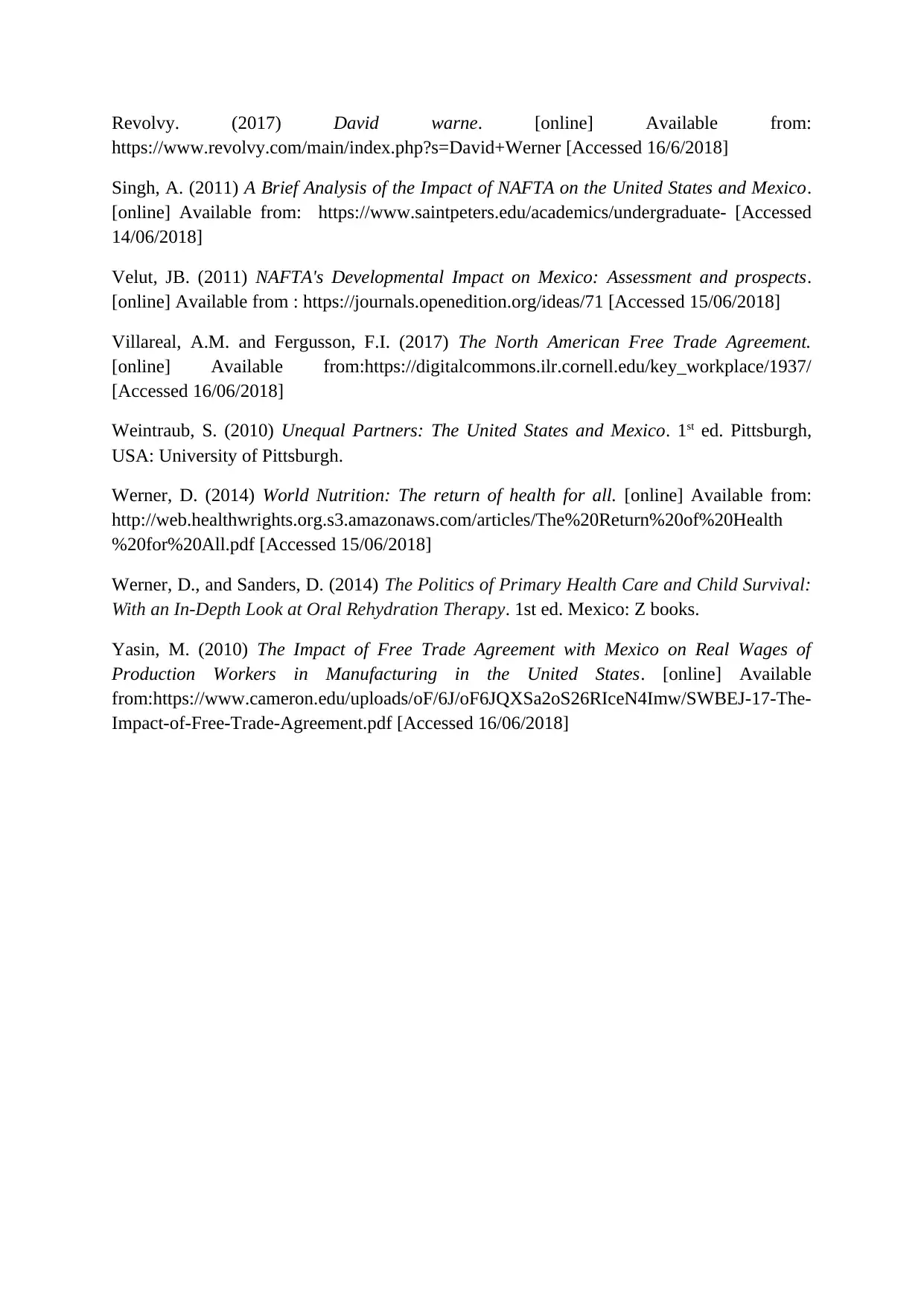
Revolvy. (2017) David warne. [online] Available from:
https://www.revolvy.com/main/index.php?s=David+Werner [Accessed 16/6/2018]
Singh, A. (2011) A Brief Analysis of the Impact of NAFTA on the United States and Mexico.
[online] Available from: https://www.saintpeters.edu/academics/undergraduate- [Accessed
14/06/2018]
Velut, JB. (2011) NAFTA's Developmental Impact on Mexico: Assessment and prospects.
[online] Available from : https://journals.openedition.org/ideas/71 [Accessed 15/06/2018]
Villareal, A.M. and Fergusson, F.I. (2017) The North American Free Trade Agreement.
[online] Available from:https://digitalcommons.ilr.cornell.edu/key_workplace/1937/
[Accessed 16/06/2018]
Weintraub, S. (2010) Unequal Partners: The United States and Mexico. 1st ed. Pittsburgh,
USA: University of Pittsburgh.
Werner, D. (2014) World Nutrition: The return of health for all. [online] Available from:
http://web.healthwrights.org.s3.amazonaws.com/articles/The%20Return%20of%20Health
%20for%20All.pdf [Accessed 15/06/2018]
Werner, D., and Sanders, D. (2014) The Politics of Primary Health Care and Child Survival:
With an In-Depth Look at Oral Rehydration Therapy. 1st ed. Mexico: Z books.
Yasin, M. (2010) The Impact of Free Trade Agreement with Mexico on Real Wages of
Production Workers in Manufacturing in the United States. [online] Available
from:https://www.cameron.edu/uploads/oF/6J/oF6JQXSa2oS26RIceN4Imw/SWBEJ-17-The-
Impact-of-Free-Trade-Agreement.pdf [Accessed 16/06/2018]
https://www.revolvy.com/main/index.php?s=David+Werner [Accessed 16/6/2018]
Singh, A. (2011) A Brief Analysis of the Impact of NAFTA on the United States and Mexico.
[online] Available from: https://www.saintpeters.edu/academics/undergraduate- [Accessed
14/06/2018]
Velut, JB. (2011) NAFTA's Developmental Impact on Mexico: Assessment and prospects.
[online] Available from : https://journals.openedition.org/ideas/71 [Accessed 15/06/2018]
Villareal, A.M. and Fergusson, F.I. (2017) The North American Free Trade Agreement.
[online] Available from:https://digitalcommons.ilr.cornell.edu/key_workplace/1937/
[Accessed 16/06/2018]
Weintraub, S. (2010) Unequal Partners: The United States and Mexico. 1st ed. Pittsburgh,
USA: University of Pittsburgh.
Werner, D. (2014) World Nutrition: The return of health for all. [online] Available from:
http://web.healthwrights.org.s3.amazonaws.com/articles/The%20Return%20of%20Health
%20for%20All.pdf [Accessed 15/06/2018]
Werner, D., and Sanders, D. (2014) The Politics of Primary Health Care and Child Survival:
With an In-Depth Look at Oral Rehydration Therapy. 1st ed. Mexico: Z books.
Yasin, M. (2010) The Impact of Free Trade Agreement with Mexico on Real Wages of
Production Workers in Manufacturing in the United States. [online] Available
from:https://www.cameron.edu/uploads/oF/6J/oF6JQXSa2oS26RIceN4Imw/SWBEJ-17-The-
Impact-of-Free-Trade-Agreement.pdf [Accessed 16/06/2018]
1 out of 8
Related Documents
Your All-in-One AI-Powered Toolkit for Academic Success.
+13062052269
info@desklib.com
Available 24*7 on WhatsApp / Email
![[object Object]](/_next/static/media/star-bottom.7253800d.svg)
Unlock your academic potential
© 2024 | Zucol Services PVT LTD | All rights reserved.



